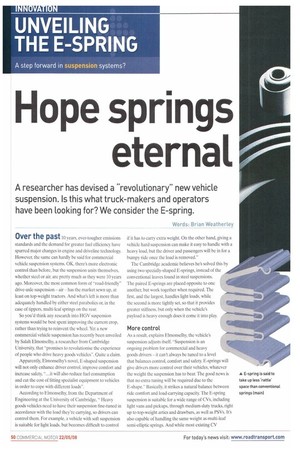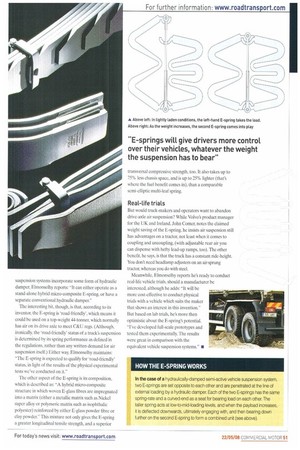Hope springs eternal
Page 50

Page 51

If you've noticed an error in this article please click here to report it so we can fix it.
A researcher has devised a "revolutionary" new vehicle suspension. Is this what truck-makers and operators have been looking for? We consider the E-spring.
Words: Brian Weatherley Over the past 10 years, ever-tougher emissions standards and the demand for greater fuel efficiency have spurred major changes in engine and driveline technology. However, the same can hardly be said for commercial vehicle suspension systems. OK, there's more electronic control than before, but the suspension units themselves, whether steel or air, are pretty much as they were 10 years ago. Moreover, the most common form of "road-friendly" drive-axle suspension — air — has the market sewn up, at least on top-weight tractors. And what's left is more than adequately handled by either steel parabolics or, in the case of tippers, multi-leaf springs on the rear.
So you'd think any research into HGV suspension systems would be best spent improving the current crop, rather than trying to reinvent the wheel. Yet a new commercial vehicle suspension has recently been unveiled by Salah Elmonselhy, a researcher from Cambridge University, that "promises to revolutionise the experience of people who drive heavy goods vehicles". Quite a claim.
Apparently, Elmonselhy's novel, E-shaped suspension will not only enhance driver control, improve comfort and increase safety, "...it will also reduce fuel consumption and cut the cost of fitting specialist equipment to vehicles in order to cope with different loads".
According to Elmonselhy, from the Department of Engineering at the University of Cambridge, " Heavy goods vehicles need to have their suspension fine-tuned in accordance with the load they're carrying, so drivers can control them. For example, a vehicle with soft suspension is suitable for light loads, but becomes difficult to control if it has to carry extra weight. On the other hand, giving a vehicle hard suspension can make it easy to handle with a heavy load, but the driver and passengers will be in for a bumpy ride once the load is removed."
The Cambridge academic believes he's solved this by using two specially-shaped E-springs, instead of the conventional leaves found in steel suspensions. The paired E-springs are placed opposite to one another, but work together when required. The first, and the largest, handles light loads, while the second is more tightly set, so that it provides greater stiffness, but only when the vehicle's payload is heavy enough does it come it into play.
More control As a result, explains Elmonselhy, the vehicle's suspension adjusts itself. "Suspension is an ongoing problem for commercial and heavy goods drivers — it can't always be tuned to a level that balances control, comfort and safety. E-springs will give drivers more control over their vehicles, whatever the weight the suspension has to bear. The good news is that no extra tuning will be required due to the E-shape." Basically, it strikes a natural balance between ride comfort and load-carrying capacity. The E-spring suspension is suitable for a wide range of CVs, including light vans and pickups, through medium-duty trucks, right up to top-weight artics and drawbars, as well as PSVs. It's also capable of handling the same weight as multi-leaf semi-elliptic springs. And while most existing CV suspension systems incorporate some form of hydraulic damper, Elmonselhy reports: "It can either operate as a stand-alone hybrid micro-composite E-spring, or have a separate conventional hydraulic damper."
The interesting bit, though, is that, according to its inventor, the E-spring is 'road-friendly', which means it could be used on a top-weight 44-tonner, which normally has air on its drive axle to meet C&U regs. (Although, ironically, the 'road-friendly' status of a truck's suspension is determined by its spring performance as defined in the regulations, rather than any written demand for air suspension itself.) Either way, Elmonselhy maintains: "The E-spring is expected to qualify for 'road-friendly' status, in light of the results of the physical experimental tests we've conducted on it."
The other aspect of the E-spring is its composition, which is described as: "A hybrid micro-composite structure in which woven E-glass fibres are impregnated into a matrix (either a metallic matrix such as Nickel super alloy or polymeric matrix such as isophthalic polyester) reinforced by either E-glass powder fibre or clay powder." This mixture not only gives the E-spring a greater longitudinal tensile strength, and a superior transversal compressive strength, too. It also takes up to 75% less chassis space, and is up to 25% lighter (that's where the fuel benefit comes in), than a comparable semi-elliptic multi-leaf spring.
Real-life trials
But would truck-makers and operators want to abandon drive-axle air suspension? While Volvo's product manager for the UK and Ireland, John Corner, notes the claimed weight saving of the E-spring, he insists air suspension still has advantages on a tractor, not least when it comes to coupling and uncoupling, (with adjustable rear air you can dispense with hefty lead-up ramps, too). The other benefit, he says, is that the truck has a constant ride-height. You don't need headlamp adjusters on an air-sprung tractor, whereas you do with steel, Meanwhile. Elmonselhy reports he's ready to conduct real-life vehicle trials, should a manufacturer be interested, although he adds: "It will be more cost-effective to conduct physical trials with a vehicle which suits the maker that shows an interest in this invention." But based on lab trials, he's more then optimistic about the E-spring's potential. "I've developed full-scale prototypes and tested them experimentally The results were great in comparison with the equivalent vehicle suspension systems." •












































































































































































